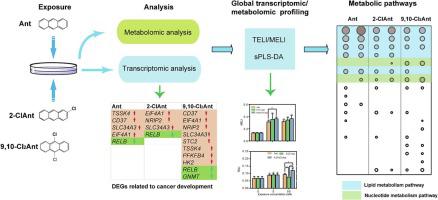当前位置:
X-MOL 学术
›
Sci. Total Environ.
›
论文详情
Our official English website, www.x-mol.net, welcomes your
feedback! (Note: you will need to create a separate account there.)
Integration approach of transcriptomics and metabolomics reveals the toxicity of Anthracene and its chlorinated derivatives on human hepatic cells
Science of the Total Environment ( IF 8.2 ) Pub Date : 2023-09-09 , DOI: 10.1016/j.scitotenv.2023.166886
Yun Luo 1 , Ningbo Geng 2 , Shuai Sun 3 , Lin Cheng 2 , Shuangshuang Chen 2 , Haijun Zhang 2 , Jiping Chen 2
Science of the Total Environment ( IF 8.2 ) Pub Date : 2023-09-09 , DOI: 10.1016/j.scitotenv.2023.166886
Yun Luo 1 , Ningbo Geng 2 , Shuai Sun 3 , Lin Cheng 2 , Shuangshuang Chen 2 , Haijun Zhang 2 , Jiping Chen 2
Affiliation

|
Polycyclic aromatic hydrocarbons (PAHs) and Chlorinated PAHs (Cl-PAHs) are ubiquitous environmental contaminants. The toxicological information of anthracene (Ant) and its chlorinated derivatives is quite limited. In this study, an integrated metabolomic and transcriptomic analysis approach was adopted to assess the toxic effects triggered by Ant and its chlorinated derivatives, 2-chloroanthracene (2-ClAnt) and 9,10-dichloroanthracen (9,10-Cl2 Ant), at human-relevant levels on human normal hepatocyte L02 cells. The cell viability test showed no significant effects on the viability of L02 cells exposed to Ant, 2-ClAnt and 9,10-Cl2 Ant at doses of 5–500 nM for 24 h. However, based on transcriptomic analysis, Ant, 2-ClAnt and 9,10-Cl2 Ant exposure at human-relevant levels obviously perturbed global gene expression in L02 cells and induced the differential expression of several genes related to cancer development. As the number of genes related to cancer development altered by 9,10-Cl2 Ant is the largest, 9,10-Cl2 Ant posed greater risks of tumor development than Ant and 2-ClAnt did. Metabolomics analysis demonstrated that Ant, 2-ClAnt and 9,10-Cl2 Ant caused significant metabolic perturbation in L02 cells. Pathway enrichment analysis indicated that Ant, 2-ClAnt and 9,10-Cl2 Ant mainly perturbed the lipid metabolism and nucleotide metabolism pathway. However, 9,10-Cl2 Ant caused a wider perturbation to metabolic pathways than Ant and 2-ClAnt did. In addition, dysregulation of nucleotide metabolism perturbed by Ant, 2-ClAnt and 9,10-Cl2 Ant may be associated with the genomic instability and further carcinogenesis.
中文翻译:

转录组学和代谢组学的整合方法揭示了蒽及其氯化衍生物对人肝细胞的毒性
多环芳烃 (PAH) 和氯化 PAH (Cl-PAH) 是普遍存在的环境污染物。蒽 (Ant) 及其氯化衍生物的毒理学信息相当有限。在本研究中,采用综合代谢组学和转录组学分析方法来评估蚂蚁及其氯化衍生物 2-氯蒽 (2-ClAnt) 和 9,10-二氯蒽 (9,10-Cl2Ant) 在人类相关水平上对人正常肝细胞 L02 细胞的毒性作用。细胞活力测试显示,暴露于 5-500 nM 剂量的 Ant、2-ClAnt 和 9,10-Cl2Ant 24 小时的 L02 细胞活力没有显著影响。然而,基于转录组学分析,Ant、2-ClAnt 和 9,10-Cl2Ant 在人类相关水平上的暴露明显扰乱了 L02 细胞中的全局基因表达,并诱导了与癌症发展相关的几个基因的差异表达。由于 9,10-Cl2Ant 改变的与癌症发展相关的基因数量最大,因此 9,10-Cl2Ant 比 Ant 和 2-ClAnt 构成更大的肿瘤发展风险。代谢组学分析表明,Ant、2-ClAnt 和 9,10-Cl2Ant 在 L02 细胞中引起显着的代谢扰动。通路富集分析表明,Ant、2-ClAnt 和 9,10-Cl2Ant 主要扰动脂质代谢和核苷酸代谢通路。然而,9,10-Cl2Ant 对代谢途径的扰动比 Ant 和 2-ClAnt 更大。此外,Ant、2-ClAnt 和 9,10-Cl2Ant 扰动的核苷酸代谢失调可能与基因组不稳定和进一步的致癌作用有关。
更新日期:2023-09-09
中文翻译:

转录组学和代谢组学的整合方法揭示了蒽及其氯化衍生物对人肝细胞的毒性
多环芳烃 (PAH) 和氯化 PAH (Cl-PAH) 是普遍存在的环境污染物。蒽 (Ant) 及其氯化衍生物的毒理学信息相当有限。在本研究中,采用综合代谢组学和转录组学分析方法来评估蚂蚁及其氯化衍生物 2-氯蒽 (2-ClAnt) 和 9,10-二氯蒽 (9,10-Cl2Ant) 在人类相关水平上对人正常肝细胞 L02 细胞的毒性作用。细胞活力测试显示,暴露于 5-500 nM 剂量的 Ant、2-ClAnt 和 9,10-Cl2Ant 24 小时的 L02 细胞活力没有显著影响。然而,基于转录组学分析,Ant、2-ClAnt 和 9,10-Cl2Ant 在人类相关水平上的暴露明显扰乱了 L02 细胞中的全局基因表达,并诱导了与癌症发展相关的几个基因的差异表达。由于 9,10-Cl2Ant 改变的与癌症发展相关的基因数量最大,因此 9,10-Cl2Ant 比 Ant 和 2-ClAnt 构成更大的肿瘤发展风险。代谢组学分析表明,Ant、2-ClAnt 和 9,10-Cl2Ant 在 L02 细胞中引起显着的代谢扰动。通路富集分析表明,Ant、2-ClAnt 和 9,10-Cl2Ant 主要扰动脂质代谢和核苷酸代谢通路。然而,9,10-Cl2Ant 对代谢途径的扰动比 Ant 和 2-ClAnt 更大。此外,Ant、2-ClAnt 和 9,10-Cl2Ant 扰动的核苷酸代谢失调可能与基因组不稳定和进一步的致癌作用有关。





































 京公网安备 11010802027423号
京公网安备 11010802027423号